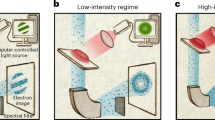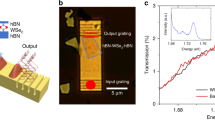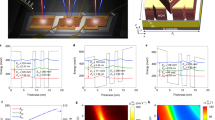Abstract
Space-variant control of optical wavefronts is important for many applications in photonics, such as the generation of structured light beams, and is achieved with spatial light modulators. Commercial devices, at present, are based on liquid-crystal and digital micromirror technologies and are typically limited to kilohertz switching speeds. To realize significantly higher operating speeds, new technologies and approaches are necessary. Here we demonstrate two-dimensional control of free-space optical fields at a wavelength of 1,550 nm at a 1 GHz modulation speed using a programmable plasmonic phase modulator based on near-field interactions between surface plasmons and materials with an electrooptic response. High χ(2) and χ(3) dielectric thin films of either aluminium nitride or silicon-rich silicon nitride are used as an active modulation layer in a surface plasmon resonance configuration to realize programmable space-variant control of optical wavefronts in a 4 × 4 pixel array at high speed.
This is a preview of subscription content, access via your institution
Access options
Access Nature and 54 other Nature Portfolio journals
Get Nature+, our best-value online-access subscription
$29.99 / 30 days
cancel any time
Subscribe to this journal
Receive 12 print issues and online access
$209.00 per year
only $17.42 per issue
Buy this article
- Purchase on Springer Link
- Instant access to full article PDF
Prices may be subject to local taxes which are calculated during checkout




Similar content being viewed by others
Data availability
The data that support the plots within this paper and other findings of this study are available from the corresponding author upon reasonable request.
References
Dudley, D., Duncan, W. M. & Slaughter, J. Emerging digital micromirror device (DMD) applications. Proc. SPIE 4985, 14–26 (2003).
Henderson, C. J., Leyva, D. G. & Wilkinson, T. D. Free space adaptive optical interconnect at 1.25 Gb/s, with beam steering using a ferroelectric liquid-crystal SLM. J. Lightwave Technol. 24, 1989–1997 (2006).
Shrauger, V. & Warde, C. Development of a high-speed high-fillfactor phase-only spatial light modulator. Proc. SPIE 4291, 101–108 (2001).
Yang, W. et al. High speed optical phased array using high contrast grating all-pass filters. Opt. Express 22, 20038–20044 (2014).
Sun, T. et al. Surface-normal electro-optic spatial light modulator using graphene integrated on a high-contrast grating resonator. Opt. Express 24, 26035–26043 (2016).
Yu, N. System, method and computer-accessible medium for depth of field imaging for three-dimensional sensing utilizing a spatial light modulator microscope arrangement. US patent application 14/763,925 (2015).
Ahearn, J. S. et al. Multiple quantum well (MQW) spatial light modulators (SLMs) for optical data processing and beam steering. Proc. SPIE 4457, 43–54 (2001).
Lucente, M., 2011. The first 20 years of holographic video—and the next 20. In Proc. 2nd Annual International Conference on Stereoscopic 3D for Media and Entertainment 21–23 (SMPTE, 2011).
Haffner, C. et al. All-plasmonic Mach–Zehnder modulator enabling optical high-speed communication at the microscale. Nat. Photon. 9, 525–528 (2015).
Hössbacher, C. et al. Plasmonic modulator with >170 GHz bandwidth demonstrated at 100 GBd NRZ. Opt. Express 25, 1762–1768 (2017).
Zayats, A. V., Smolyaninov, I. I. & Maradudin, A. A. Nano-optics of surface plasmon polaritons. Phys. Rep. 408, 131–314 (2005).
Tetz, K., Rokitski, R., Nezhad, M. & Fainman, Y. Excitation and direct imaging of surface plasmon polariton modes in a two-dimensional grating. Appl. Phys. Lett 86, 111110 (2005).
Rokitski, R., Tetz, K. A. & Fainman, Y. Propagation of femtosecond surface plasmon polariton pulses on the surface of a nanostructured metallic film: space–time complex amplitude characterization. Phys. Rev. Lett. 95, 177401 (2005).
Huang, Y. H., Ho, H. P., Wu, S. Y. & Kong, S. K. Detecting phase shifts in surface plasmon resonance: a review. Adv. Opt. Technol. 2012, 471957 (2012).
Nakkach, M., Duval, A., Ea-Kim, B., Moreau, J. & Canva, M. Angulo-spectral surface plasmon resonance imaging of nanofabricated grating surfaces. Opt. Lett. 35, 2209–2211 (2010).
Nikitin, P. I. et al. Surface plasmon resonance interferometry for micro-array biosensing. Sens. Actuat. A 85, 189–193 (2000).
Dong, W. et al. Improved polarization contrast method for surface plasmon resonance imaging sensors by inert background gold film extinction. Opt. Commun. 346, 1–9 (2015).
Piliarik, M., Vaisocherová, H. & Homola, J. A new surface plasmon resonance sensor for high-throughput screening applications. Biosens. Bioelectron. 20, 2104–2110 (2005).
Piliarik, M., Katainen, J. & Homola, J. Novel polarization control for high-throughput surface plasmon resonance sensors. Opt. Sens. Technol. Appl. 6585, 658515 (2007).
Homola, J. & Yee, S. S. Novel polarization control scheme for spectral surface plasmon resonance sensors. Sens. Actuat. B 51, 331–339 (1998).
Huang, Y. H., Ho, H. P., Kong, S. K. & Kabashin, A. V. Phase‐sensitive surface plasmon resonance biosensors: methodology, instrumentation and applications. Ann. Phys. 524, 637–662 (2012).
Moirangthem, R. S., Chang, Y. C., Hsu, S. H. & Wei, P. K. Surface plasmon resonance ellipsometry based sensor for studying biomolecular interaction. Biosens. Bioelectron. 25, 2633–2638 (2010).
Liu, C., Liu, Q. & Hu, X. SPR phase detection for measuring the thickness of thin metal films. Opt. Express 22, 7574–7580 (2014).
Yeatman, E. M. & Caldwell, M. E. Spatial light modulation using surface plasmon resonance. Appl. Phys. Lett. 55, 613–615 (1989).
Kogan, P., Apter, B., Baal-Zedaka, I. & Efron, U. Resolution improvement of surface plasmon-enhanced, liquid crystal spatial light modulator: simulation studies. Opt. Commun. 281, 4788–4792 (2008).
Yariv, A. & Yeh, P. Photonics: Optical Electronics in Modern Communications (Oxford Univ. Press, New York, 2006).
Xiong, C., Pernice, W. H. & Tang, H. X. Low-loss, silicon integrated, aluminum nitride photonic circuits and their use for electro-optic signal processing. Nano Lett. 12, 3562–3568 (2012).
Lin, H. H. et al. 2017. Enhanced effective second-order nonlinearities in Si-rich SiNx thin films. In 2017 Conference on Lasers and Electro-Optics (CLEO) SM1M.6 (Optical Society of America, 2017).
Shen, S., Liu, T. & Guo, J. Optical phase-shift detection of surface plasmon resonance. Appl. Opt. 37, 1747–1751 (1998).
Kurihara, K. & Suzuki, K. Theoretical understanding of an absorption-based surface plasmon resonance sensor based on Kretchmann’s theory. Anal. Chem. 74, 696–701 (2002).
Raether, H. in Surface Plasmons on Smooth and Rough Surfaces and on Gratings 91–116 (Springer, Berlin, 1988).
Deng, S., Wang, P. & Yu, X. Phase-sensitive surface plasmon resonance sensors: recent progress and future prospects. Sensors 17, 2819 (2017).
An, Z., Men, C., Xu, Z., Chu, P. K. & Lin, C. Electrical properties of AlN thin films prepared by ion beam enhanced deposition. Surf. Coatings Technol. 196, 130–134 (2005).
Rauthan, C. M. S. & Srivastava, J. K. Electrical breakdown voltage characteristics of buried silicon nitride layers and their correlation to defects in the nitride layer. Mater. Lett. 9, 252–258 (1990).
Yota, J. Effects of deposition method of PECVD silicon nitride as MIM capacitor dielectric for GaAs HBTtechnology. ECS Trans. 35, 229–240 (2011).
McManamon, P. F. et al. A review of phased array steering for narrow-band electrooptical systems. Proc. IEEE 97, 1078–1096 (2009).
Swanson, G. J. 1989. Binary Optics Technology: The Theory and Design of Multi-level Diffractive Optical Elements Report No. TR-854 (Massachusetts Institute of Technology Lincoln Laboratory, Lexington, 1989).
Broomfield, S. E., Neil, M. A. A., Paige, E. G. S. & Yang, G. G. Programmable binary phase-only optical device based on ferroelectric liquid crystal SLM. Electron. Lett. 28, 26–28 (1992).
Weigel, P. O. et al. Lightwave circuits in lithium niobate through hybrid waveguides with silicon photonics. Sci. Rep. 6, 22301 (2016).
Chang, L. et al. Heterogeneous integration of lithium niobate and silicon nitride waveguides for wafer-scale photonic integrated circuits on silicon. Opt. Lett. 42, 803–806 (2017).
Heck, M. J. Highly integrated optical phased arrays: photonic integrated circuits for optical beam shaping and beam steering. Nanophotonics 6, 93–107 (2017).
Acknowledgements
This work was supported by the Defense Advanced Research Projects Agency (DARPA), DARPA NLM, DARPA MOABB, the Office of Naval Research (ONR) Multidisciplinary University Research Initiative (MURI), the National Science Foundation (NSF) grants DMR-1707641, CBET-1704085, ECCS-1405234, ECCS-1644647, CCF-1640227 and ECCS-1507146, the NSF ERC CIAN, the Semiconductor Research Corporation (SRC), the NSF’s NNCI San Diego Nanotechnology Infrastructure (SDNI), the Chip-Scale Photonics Testing Facility (CSPTF), Nano3, the Army Research Office (ARO) and the Cymer Corporation.
Author information
Authors and Affiliations
Contributions
A.S. designed and characterized the PPPM and experimental set-ups, with input from A.E. and Y.F. Device fabrication was performed by A.S. and F.V. Design feedback for high speed characterization and performance analysis was provided by S.P. A.S., A.E.A. and Y.F. wrote the manuscript with input from S.P. and F.V. Y.F. supervised the project.
Corresponding author
Ethics declarations
Competing interests
The authors declare no competing interests.
Additional information
Publisher’s note: Springer Nature remains neutral with regard to jurisdictional claims in published maps and institutional affiliations.
Supplementary Information
Supplementary Information
Detailed analysis of the device’s wavelength and angular response.
Rights and permissions
About this article
Cite this article
Smolyaninov, A., El Amili, A., Vallini, F. et al. Programmable plasmonic phase modulation of free-space wavefronts at gigahertz rates. Nat. Photonics 13, 431–435 (2019). https://doi.org/10.1038/s41566-019-0360-3
Received:
Accepted:
Published:
Issue Date:
DOI: https://doi.org/10.1038/s41566-019-0360-3
This article is cited by
-
Large-volume focus control at 10 MHz refresh rate via fast line-scanning amplitude-encoded scattering-assisted holography
Nature Communications (2024)
-
A full degree-of-freedom spatiotemporal light modulator
Nature Photonics (2022)
-
Gigahertz free-space electro-optic modulators based on Mie resonances
Nature Communications (2022)
-
Enhancing spatiotemporal light modulators
Nature Photonics (2022)
-
Electro-optic spatial light modulator from an engineered organic layer
Nature Communications (2021)



